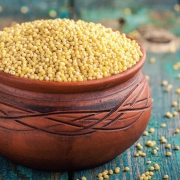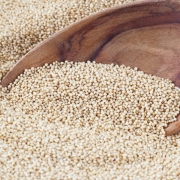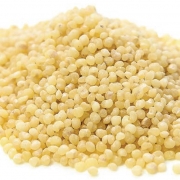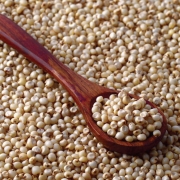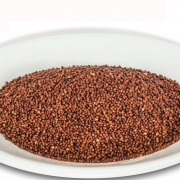
Health
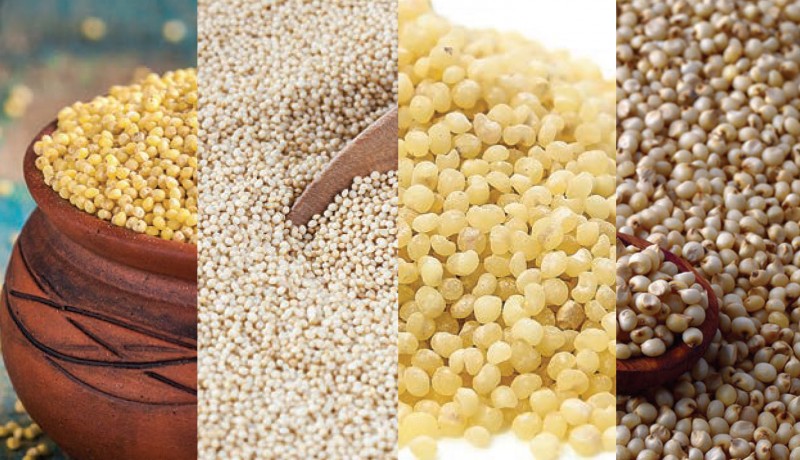
Wellness consultant Naini Setalvad delves into the goodness of the ancient super crops, millets
We’re lucky to belong to a country that has a variety of millets and need not depend on wheat and rice as our only source of grain. Millets are one of the oldest foods known to humans and possibly the first cereal grain to be used for domestic purposes. In India, grains vary from season to season as food is classified as heat-forming or cooling. In fact, ours is probably one of the only cuisines in the world that uses so many millets in various forms, changing from region to region. In this column, we will tell you more about the different types of millets along with their benefits and nutritive value for silvers. Remember, all the grains mentioned below are gluten-free!
Bajra (pearl millet)
A wonder grain for seniors, bajra is usually consumed when the temperature drops. Indeed, the best season to eat it is winter as it is grown at the end of the monsoon. This crop needs light rainfall and bright sunlight; it is harvested thereafter in the beginning of winter. Along with its natural sweet taste, it produces warmth in the body and keeps you satiated for a long time, thus making it an ideal choice of grain. Its high Vitamin B6 content keeps away pain in the nerves while the magnesium content works as a muscle relaxant and the potassium keeps your blood pressure low. Bajre ki roti, paired with baingan ka bharta, is a staple food in Gujarat during the winter months. With bajra, you can also make delicious savoury porridge and thepla with fenugreek that can replace your rotis and be eaten at breakfast instead of bread or parathas. Bajra rotis taste delicious with ghee, white butter (if you want to indulge!) and garlic chutney.
BAJRA PORRIDGE
Ingredients
- Bajra seeds: 1 cup; coarsely ground
- Mixed vegetables (capsicum, tomato, beans, etc): 1 cup; chopped
- Carom seeds (ajwain): 1 tsp
- Asafoetida (hing): ¼ tsp
- Neem leaves: 4-5
- Turmeric powder: ½ tsp
- Green chilli paste: to taste
- Salt to taste
- Water to cook
- Oil: 1 tsp
Method
Heat oil in a pan. Add ajwain, hing and neem leaves to it. Sauté till they crackle. Add the bajra seeds and roast for a few minutes. Add water, turmeric powder, green chilli paste and salt. When half-cooked, add the vegetables. Once cooked well, take it off the flame. Garnish with coriander leaves and serve hot.
Rajgira (amaranth)
The world is going gaga over this grain, which is now being called a 21st-century super food. In India, though, rajgira has been synonymous with the fasting season since ancient times. Packed with healthy nutrients, this versatile food can be made into pastas, breads, porridges and chapattis. The flour is made from rajgira seeds that are rich in calcium, magnesium, folate, potassium, phosphorous and vitamins A, C and E. It’s a good source of protein; a rajgira roti is a complete meal when combined with a vegetable and buttermilk. Rajgira controls blood sugar and insulin levels, keeping hunger at bay and preventing the development of Type 2 diabetes and heart disease. It also helps reduce bad cholesterol and prevents osteoporosis. So silvers, don’t just think of it as a food for fasting; incorporate it regularly in your diet!
RAJGIRA KADHI
Ingredients
- Rajgira flour: ¼ cup
- Yoghurt: 1½ cups
- Rock salt to taste
- Ghee: 2 tsp
- Curry leaves: 4-5
- Cumin seeds (jeera): 1 tsp
- Ginger: 1 tsp; grated
- Green chillies: 3; sliced
Method
Combine the rajgira flour, yoghurt and rock salt in a deep bowl and whisk together. Add 2 cups of water and mix well. Keep aside. Heat ghee in a pan and add the cumin seeds. When they crackle, add ginger, curry leaves and green chillies and sauté on medium flame for a few seconds. Then, add to the flour and yoghurt mixture. Mix well and cook the mixture on medium flame for 7 minutes, while stirring continuously. Lower the flame and cook for 2-3 minutes more, while stirring occasionally. Serve hot with sama rice.
Sama (barnyard millet)
Also known also as verghu, vari or moriya in different parts of India, sama has a very high fibre content and around 11 per cent protein; its nutritional value has been found to be slightly better than other small millets. It helps keep diabetes under check, controls obesity, helps heal wounds and has a tranquilising effect. The perfect substitute for rice (you can eat it every day), it keeps you satiated longer like all other millets. Make it into a one-pot meal by adding a water-based vegetable such as bottle gourd, after grating and lightly sautéing it with ghee and cumin seeds.
SAMA RICE
Ingredients
- Sama rice: 1 cup
- White gourd: 250 gm
- Hot water: 2 cups
- Cumin seeds: ½ tsp
- Green chilli: 1; chopped
- Ginger paste: 1 tsp
- Fresh coconut (optional): 2 tbsp; grated
- Coriander leaves: 2 tbsp; chopped
- Cow’s ghee: ½ tbsp
- Rock salt to taste
Method
Dry-roast the sama rice till it turns light brown. Heat ghee in a pan; add cumin seeds, green chilli, ginger paste and grated coconut. Saute for a minute. Add white gourd and cook for 5 minutes. Add sama rice and rock salt and mix well. Add hot water and mix again. Cover with a lid and lower the flame. Cook till the water gets absorbed and the rice becomes soft. Garnish with coriander and serve.
Jowar (sorghum)
Jowar, the second most popular crop in India, helps maintain a good heart and healthy blood sugar levels. It is easy to digest and thus very comfortable for seniors to consume. Jowar contains nearly 47 per cent of the required daily intake of iron for women and over 100 per cent of the RDA (recommended dietary allowance) for men, making it ideal for silvers. It is an ideal grain to be had during the silver years when the iron content tends to reduce. Further, each cup/serving of jowar provides about 78 per cent of the daily intake of phosphorus for adults, which is essential to support the growth and maintenance of bones. Eating thiamine-rich foods like jowar also lowers your risk of neurodegenerative problems such as Alzheimer’s disease and eye problems like cataract. Each cup/serving of jowar provides men with 38 per cent and women with 41 per cent of their recommended daily intake of thiamine. What’s more, jowar bhakri are yummy to eat—hot or cold!
JOWAR ROTI
Ingredients
- Jowar flour: 100 gm
- Water: 100 ml
- Chilli paste: ½ tsp
- Coriander: ½ cup; chopped
- Salt to taste
Method
Take water in a vessel and heat on medium flame. As it starts boiling, add the jowar flour, chilli paste and coriander leaves and leave it for 2-3 minutes. Do not stir. Take off the flame. Stir with a wooden spoon so lumps are not formed. After it is mixed well, cool for five minutes and transfer onto a flat plate. Knead well. Roll the dough into rotis and cook them on a flat griddle, using ghee if desired.
Nachani/ragi (finger millet)
The best way to keep your bones strong is to eat this wonderful millet in any form. In addition to being an excellent source of calcium, nachani has multiple health benefits. The fibre content reduces cholesterol and blood sugar. Being a good source of iron, it combats anaemia. And being a good source of protein, it helps in muscle mass formation. Nachani porridge along with bhakri is a common food in Southern India and Maharashtra—it’s worth including in your diet no matter which part of India you live in.
NACHANI KHICHU
Ingredients
- Nachani flour: ¾ cup
- Low-fat yoghurt: 1½ tbsp
- Cumin seeds: 1 tsp
- Ginger-chilli paste: 2 tsp
- Coriander leaves: ½ cup; chopped
- Asafoetida (hing): ¼ tsp
- Oil: 1 tsp
- Salt to taste
- Lemon juice to taste
Method
Beat the yoghurt in 1½ cup water. Add ginger-chilli paste, hing, salt and cumin seeds. Heat this mixture on a medium flame for 3-5 minutes. As it starts boiling, add the nachani flour and mix well. Stir constantly to avoid lumps. Cover with a lid and cook on slow flame for 10 minutes. Add oil and mix well. Now, add lemon juice and coriander, mix well and simmer again for 2 minutes. Serve hot.
Setalvad is an obesity and lifestyle disease consultant who offers diet counselling at Health for You, a wellness clinic in Mumbai, as well as online. Visit www.nainisetalvad.com for more details or write to contact.us@harmonyindia.org if you have any queries for her
Photos: 123RF.com Featured in Harmony — Celebrate Age Magazine September 2017
you may also like to read
-
Hot tea!
If you enjoy sipping on that steaming hot cup of tea, think twice. New research establishes a link between drinking….
-
Weight and watch
If you have stayed away from lifting weights at the gym, thinking it might not be a good idea for….
-
Toothy truth
Research has established a clear association between cognitive function and tooth loss when cognitive function score was categorised into quintiles…..
-
PRODUCT OF THE MONTH
Automatic Blood Pressure Monitor Measure your blood pressure and pulse rate with no fuss Hypertension, or high blood pressure, could….



